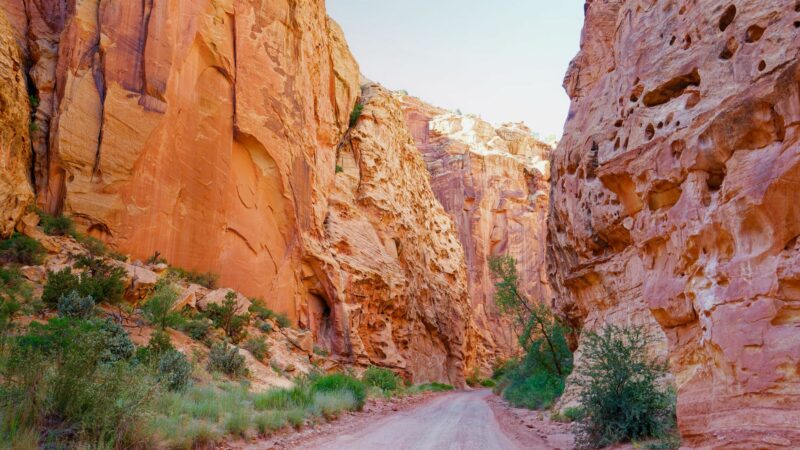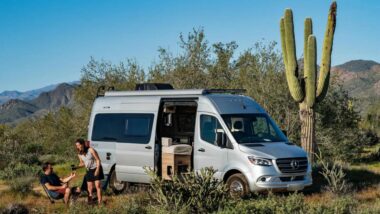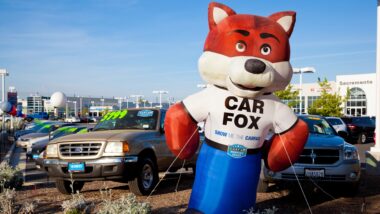Table of Contents Show
When you hear the name Capitol Reef National Park, you may think it’s near a coastline and protects a delicate coral reef system. But this national treasure sits in a landlocked state about 800 miles from the Pacific Ocean.
Instead of preserving a coral reef, Capitol Reef National Park preserves a unique monocline, a Waterpocket Fold, in Utah. This dramatic shift in the earth is part of the greater Colorado Plateau where canyons, arches, spires, and other unique rock formations abound.
Let’s learn more about this unique national park in the Beehive State!
Where Is Capitol Reef National Park?
Utah is famous for its “Mighty Five” national parks. Zion, Bryce Canyon, Capitol Reef, Canyonlands, and Arches are some of the most popular national parks in the country. And they’re all within a day’s drive of each other. Capitol Reef National Park sits in the middle of these five parks in south-central Utah.
Grand Staircase-Escalante National Monument is to the south, Highway 12 runs along the western border, and Highway 24 runs straight through the northern part of the park.
When Did Capitol Reef National Park Become A National Park?
In 1937, President Franklin D. Roosevelt signed a proclamation creating Capitol Reef National Monument, which protected approximately 37,700 acres in south-central Utah.
By the late 1960s, the monument covered over 254,000 acres, and Congressmen began introducing bills to make it a national park instead. President Richard Nixon signed a bill passed by Congress to redesign Capitol Reef National Monument as Capitol Reef National Park on December 18, 1971.
In 1972, the first full year of Capitol Reef National Park, over 251,000 people visited the park. Fast-forward 50 years to 2022, and over 1.2 million people visited Capitol Reef National Park.
What’s So Special About Capitol Reef National Park?
Capitol Reef National Park protects the 100-mile Waterpocket Fold, a geologic monocline, a wrinkle on the earth.
This Waterpocket Fold formed between 50 and 70 million years ago when movement along this fault caused the west side to shift upwards more than the east side.
In fact, the west side of the monocline is 7,000 feet higher than the east side!
The park is also filled with cliffs, canyons, domes, arches, spires, monoliths, and bridges that define Red Rock Country in Utah.
The Fruita Historic District is famous for its verdant valley. The orchards were planted in the pioneer days and continue to bear fruit.
Today, over 1,900 trees produce apples, apricots, cherries, peaches, pears, and plums for visitors to enjoy during picking season.
3 Most Popular Attractions In Capitol Reef National Park
Capitol Reef National Park covers approximately 377 square miles and ranges from from 4,000 to over 11,000 feet.
There’s a lot to see and do here, much more than what you can do in a day. But if you’re time is limited, we suggest doing at least these three things.
1. Buy A Pie At the Gifford House
The Gifford Homestead is about one mile south of the visitor center. The Giffords, as well as other residents of Fruita in the early 1900s, raised and grew all of their food.
In 1969, the Giffords sold their home and land to the National Park Service. Today, visitors can head over to the Gifford House and buy one of their famous pies made from the fruit of the Fruita orchards.
There are also unique handmade items, historic postcards, and other novelties available for purchase. Just make sure to show up before lunch and the pies often sell out!
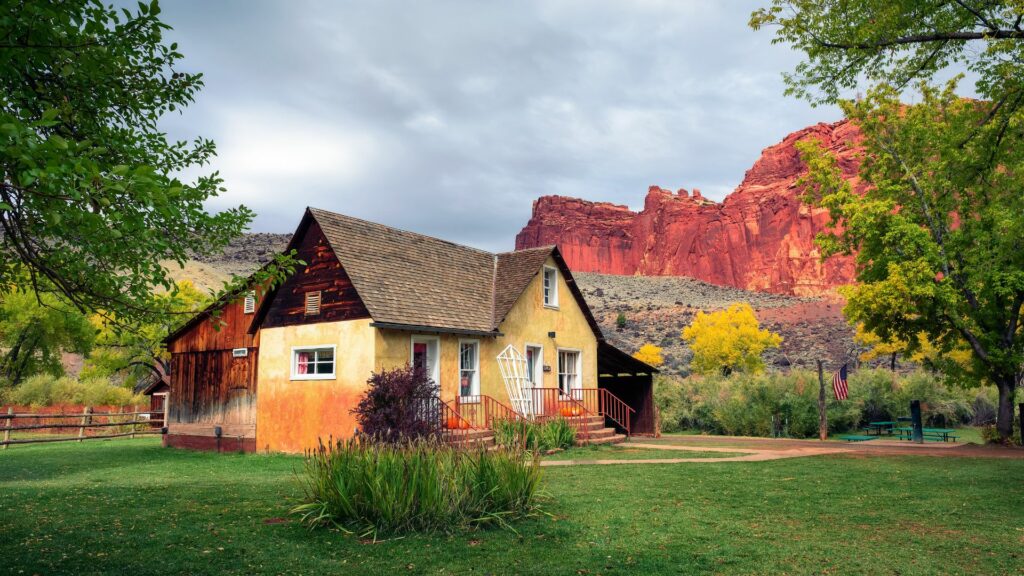
2. View the Fremont Culture Petroglyphs
After visiting the Gifford House, the Fremont culture petroglyphs are just down Utah Highway 24.
Two boardwalks lead to a viewing area. Make sure to bring your binoculars as some of the carvings are difficult to see depending on how the sunlight shines.
There are humans, bighorn sheep, and other animals on the rock face. These ancient petroglyphs date back to 300-1300 CE.

3. Hike to Hickman Bridge
One of the most popular trails in Capitol Reef National Park is the hike to Hickman Bridge.
You’ll enjoy high desert views and walk through a variety of rock formations.
The Hickman Bridge, a natural rock arch, spans 133 feet. The hike to the bridge is 0.9 miles and is rated as moderate for its 400-foot change in elevation.
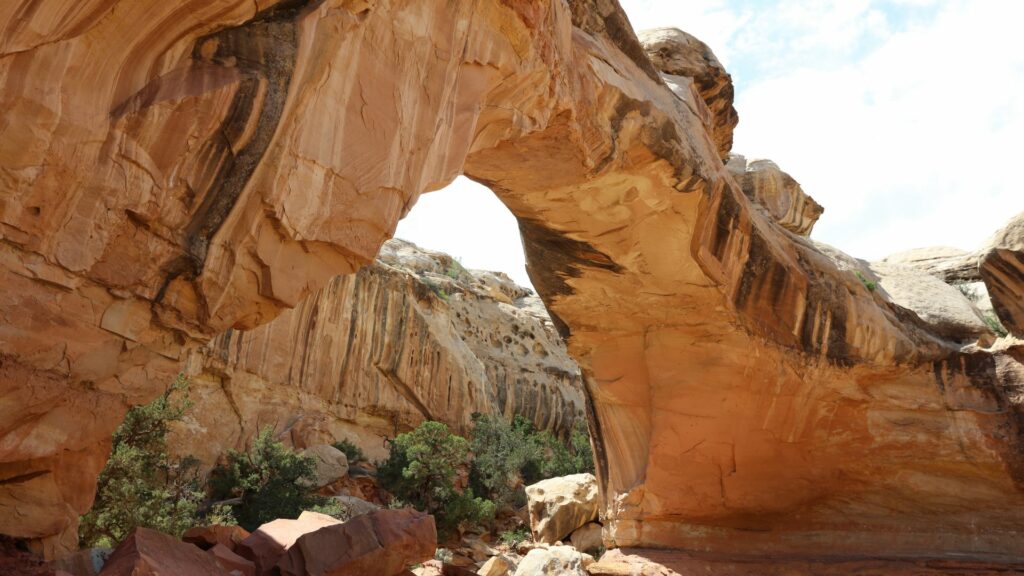
The southern section of Capitol Reef National Park is the Waterpocket District.
It’s remote and rugged, but most vehicles can safely get around in normal weather conditions.
The entire 124-mile Loop-the-Fold Driving Tour takes anywhere from four to six hours.
But if you have the time, it’s one of the best ways to see the majority of Capitol Reef.
Pick up a map at the visitor center and then follow Highway 24 east to Notom-Bullfrog Road.
Best Place For Camping Near Capitol Reef National Park
The only campground in Capitol Reef National Park is Fruita Campground. There are 71 campsites with no hookups. However, RVers have access to a dump station and potable water.
From March 1 – October 31, you must make a reservation on Recreation.gov. It’s $25/night. However, Fruita Campground often fills up during peak season.
There’s also BLM camping around the national park and within Fishlake National Forest. Singletree Campground is the largest in the area. There’s a dump station, and all roads are paved. Sites are $20/night, and reservations can be made on Recreation.gov.
Is Visiting Capitol Reef National Park Worth It?
Capitol Reef National Park isn’t as famous as its neighboring parks in Zion or Arches, but it’s still worth visiting. Because of its remote location, though, you’ll want to spend a few days here. It’s a long drive from I-70, I-15, and Highway 89, the major roads in this part of Utah.
So find a boondocking spot on BLM land or book a campsite at Fruita Campground far in advance to enjoy a few days and nights exploring this magnificent Waterpocket Fold, orchards, and rock formations.
Have you ever visited Capitol Reef National Park?




